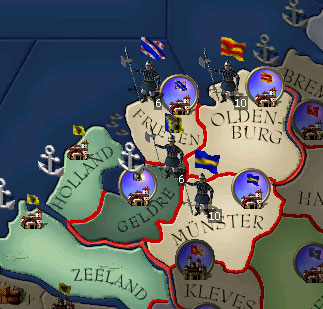Europa Multiversalis
So Europa Universalis III is out. And everyone knows what a Paradox fanboi I am, so clearly I should be raving about this!
My initial impressions aren’t that good.
It’s UGLY. This is using a new 3D engine for Paradox and… it’s just bad. Sure, the screenshots on the website look fine, but most of the time? This is what you’ll be looking at.


Let’s play GUESS THE UPGRADE
On the left, EU3. On the right, EU2. Considering that EU2’s core engine is seven years old (and can run quite well on old laptops), this isn’t much of an improvement. Sure, this series isn’t about eye candy, but the entire enterprise’s user interface just feels slapdash. And this doesn’t just extend to the look and feel. Many automation features seem to have gotten lost in translation, such as the ability to autosend merchants to centers of trade when they come available. Sure, it’s *better* to micromanage that, but just removing the option to have the AI do it… this is an upgrade?
More seriously, the underlying event model, which is really kind of the point with this series, was completely redone. No longer are you competing against the march of history as represented in deterministic events, the primary attraction for history boffins who enjoyed this series and didn’t play it merely to try to see if they could conquer the world with the Duchy of Modena. Instead, the game tries to model cause and effect. Instead of having a hardcoded Hussite Revolt in Bohemia in 1589, you might, if you have a peasant revolt in Bulgaria, and you don’t send troops in time, then you’ll maybe get an event that says “The Bulgarian minority is revolting!” In case you, you know, missed it. And it’s not just minor things that are left to this model. Say, the Protestant Reformation. Better hope somebody in Germany eventually gets a good religious advisor or Europe may be stuck paying indulgences to Friar Tetzel for a while.
This is obviously based on the Crusader Kings model, which worked to a degree for that game. But for modeling 400 years of European History? Not gonna happen. History is just simply too complex to be effectively modeled by an AI script without the human intervention of deterministic events. The fact that EU3 stops at 1792, whereas EU2 goes on to 1820, is illustrative. Because in EU3, how would you ever model a Napoleon Bonaparte? Either you try, and every so often the player is given a free gift of SUPER RULER, OWNER OF THE WORLD — or you don’t. Napoleon was one of those historic leaders that simply can’t be created by a random dice roll.
So instead of a game which could go a long way towards teaching you why history happened (which EU2, and the Hearts of Iron series both do very well), you get – a sandbox. With a multiverse – an infinite variety of Europes, all of which sort of vaguely resemble the one in books. Which tells you maybe that England was a bunch of right badasses, and the Ottomans were hard to throw out of Europe. But it doesn’t tell you squat about, say, the War of the Roses. Because it’ll never happen. If it does, it’s “Oh, Random Leader Zed decided he’d take half your empire.” Not really the same echoes of history there, really. It’s more of a sandbox, and thus becomes less interesting.
There are some improvements, to be sure. Military tradition is modeled, so England is a mother of a powerhouse starting out. I messed around with an Irish fiefdom, took out some loans and recruited about 10,000 mercenaries (in EU3 a monster army) and threw them at the 2000-strong English garrison in Meath. Which promptly laughed and picked its teeth with the pikes of the few survivors. OK, so conquering the world as Ireland may pose a few issues. Diplomacy is richer. The Victoria system of modeling government types makes an appearance. Stuff like that.
Again, this is just a first glance, the result of a few hours of gameplay. But dear god, the gameplay better get better soon, because this game sure got ugly. And I don’t just mean the map colors.